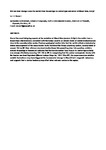Did sea-level change cause the switch from fissure-type to central- type volcanism at Mount Etna, Sicily?
| dc.contributor.author | Stewart, I | |
| dc.date.accessioned | 2018-09-10T16:15:17Z | |
| dc.date.available | 2018-09-10T16:15:17Z | |
| dc.date.issued | 2018-03 | |
| dc.identifier.issn | 0705-3797 | |
| dc.identifier.issn | 2586-1298 | |
| dc.identifier.uri | http://hdl.handle.net/10026.1/12330 | |
| dc.description.abstract |
One of the most intriguing aspects of the evolution of Mount Etna (eastern Sicily) is the switch from a fissure-type shield volcano coincident with the Ionian coast to an inland cluster of nested stratovolcanoes close to the currently active centre. Previous geological studies infer that the switch reflects a tectonically-driven rearrangement of the major border faults that direct the Etnean plumbing system, loosely dated at around 125 ka BP. New offshore structural studies throw this prevailing view into question, whilst a revised chronological framework indicates that the transformation from fissure- to central-type activity was abrupt, effectively occurring 129–126 ka BP. In recognising that this period corresponds closely with the Eemian sea-level highstand (Marine Isotope Stage 5e; 124–119 ka BP), the paper examines whether eustatic fluctuations may have triggered the fundamental change in Mount Etna’s magmatic behaviour, and suggests that a similar tendency may affect other volcanic centres in the region. | |
| dc.format.extent | 7-16 | |
| dc.language | en | |
| dc.language.iso | en | |
| dc.publisher | International Union of Geological Sciences | |
| dc.subject | 37 Earth Sciences | |
| dc.subject | 3705 Geology | |
| dc.title | Did sea-level change cause the switch from fissure-type to central- type volcanism at Mount Etna, Sicily? | |
| dc.type | journal-article | |
| dc.type | Article | |
| plymouth.author-url | https://www.webofscience.com/api/gateway?GWVersion=2&SrcApp=PARTNER_APP&SrcAuth=LinksAMR&KeyUT=WOS:000430157100002&DestLinkType=FullRecord&DestApp=ALL_WOS&UsrCustomerID=11bb513d99f797142bcfeffcc58ea008 | |
| plymouth.issue | 1 | |
| plymouth.volume | 41 | |
| plymouth.publication-status | Published | |
| plymouth.journal | Episodes | |
| dc.identifier.doi | 10.18814/epiiugs/2018/v41i1/018002 | |
| plymouth.organisational-group | /Plymouth | |
| plymouth.organisational-group | /Plymouth/Faculty of Science and Engineering | |
| plymouth.organisational-group | /Plymouth/Research Groups | |
| plymouth.organisational-group | /Plymouth/Research Groups/Marine Institute | |
| plymouth.organisational-group | /Plymouth/Users by role | |
| plymouth.organisational-group | /Plymouth/Users by role/Researchers in ResearchFish submission | |
| dcterms.dateAccepted | 2017-09-20 | |
| dc.rights.embargodate | 2019-6-14 | |
| dc.identifier.eissn | 2586-1298 | |
| dc.rights.embargoperiod | Not known | |
| rioxxterms.versionofrecord | 10.18814/epiiugs/2018/v41i1/018002 | |
| rioxxterms.licenseref.uri | http://www.rioxx.net/licenses/all-rights-reserved | |
| rioxxterms.licenseref.startdate | 2018-03 | |
| rioxxterms.type | Journal Article/Review |


